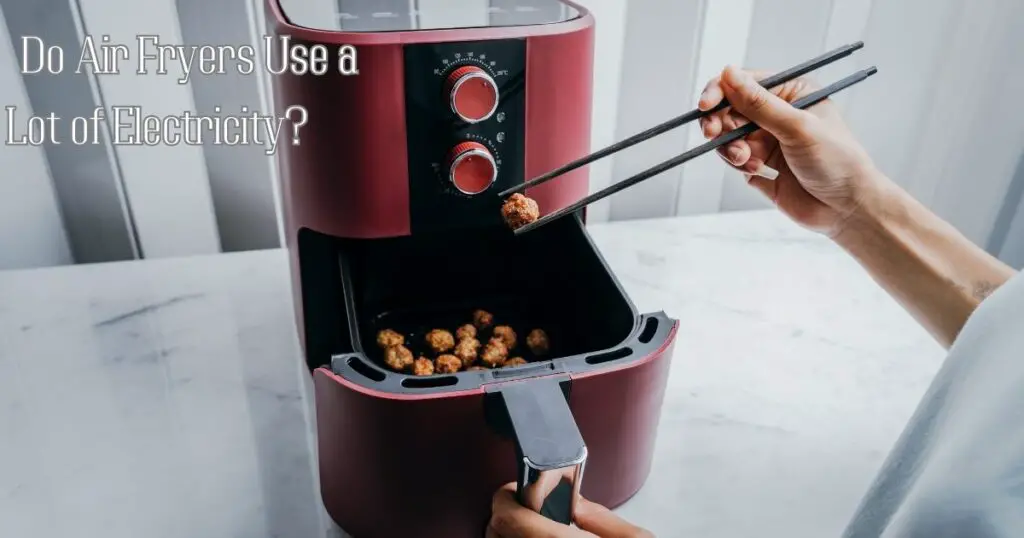Table Of Contents
Air fryers and microwave ovens are distinct kitchen appliances with different cooking principles. Air fryers use hot air circulation to cook food, relying on convection to produce a crispy texture akin to frying but with significantly less oil. They work well to cook and reheat foods that benefit from a crispy exterior.
On the other hand, microwave ovens use electromagnetic waves to speedily heat and cook food. Microwaves are ideal for reheating leftovers or cooking items that require moisture retention but do not provide the same crispiness as air fryers.
The decision ultimately comes down to the desired cooking result. Air fryers are better for achieving a crispy texture, while microwaves excel at speed and moisture retention.

What is an Air Fryer?
An air fryer is a versatile kitchen equipment that cooks food by quickly circulating hot air around it. This convection cooking method produces a crispy texture akin to frying, using substantially less oil. Air fryers can handle baking, roasting, grilling, and frying tasks, making them a healthier cooking alternative.
How Does an Air Fryer Work?
To cook food, an air fryer uses convection frying and rapid air movement. Here is how it works:
Heating Element
An air fryer’s powerful heating element, which is typically found at the top of the appliance, is its central component. This element is responsible for rapidly heating the air within the cooking chamber.
Fan
Above the heating element sits a robust, high-speed fan. It actively draws in surrounding air and then propels it downward into the cooking chamber, setting the stage for the air frying process to unfold.
Air Circulation
As the fan propels the hot air downward, it passes through a series of openings or vents. This hot air then circulates the food in the cooking basket.
Cooking Basket or Tray
The food you intend to cook is placed in a perforated basket or on a tray inside the air fryer. These perforations allow the hot air to reach the food from all sides.
Convection Cooking
The process of rapidly circulating hot air around the food is known as convection cooking. It mimics the effect of traditional frying by providing consistent, all-around heat.
Crisping and Browning
The hot air evaporates moisture from the surface of the food, producing a crispy and browned finish. This effect is similar to deep frying but uses much less oil, making it a healthy option.
Temperature and Time Control
The majority of air fryers have digital controls that let you specify particular cooking temperatures and times. This precision enables you to tailor the cooking process to your recipe’s requirements.
Safety Features
Many air fryers have an automated shut-off mechanism that activates after the cooking cycle is over for safety. This prevents overcooking and minimizes the risk of accidents.
Pros and Cons of an Air Fryer
Here’s a table summarizing the pros and cons of an air fryer:
| Pros | Cons |
| Healthier Cooking | Limited Capacity |
| Reduced Oil Usage | Can Be Noisy |
| Faster Cooking Times | Initial Cost |
| Versatile Cooking | Takes Up Counter Space |
| Easy to Use | Learning Curve for Optimal Results |
| Energy Efficiency | Not Ideal for Certain Foods |
| Less Mess and Cleanup | Can Produce Dry Results |
| Can Reheat Food Effectively | Limited Cooking Vessel Variety |
What is Microwave Oven?
A microwave oven is a kitchen equipment that quickly heats and cooks food using electromagnetic waves, primarily microwaves. These waves cause the water molecules in the food to vibrate, which warms the whole thing up. Microwave ovens are used for reheating, defrosting, and cooking a variety of dishes due to their quickness and convenience.
How Does a Microwave Oven Work?
Microwave ovens operate by releasing electromagnetic waves, specifically microwaves, into the cooking chamber. Here is an explanation of how it works:
1. Microwave Generation
A magnetron, which is located inside the microwave oven, performs an important role. A vacuum tube that produces microwave radiation is called a magnetron. These microwaves are electromagnetic waves with a specific frequency, typically around 2.45 gigahertz (GHz).
2. Microwave Emission
Once generated, a waveguide is used to send the microwaves into the cooking chamber. The waveguide is a metal tube that channels and confines microwaves to keep them from escaping beyond the oven.
3. Microwave Interaction
As the microwaves enter the cooking chamber, they interact with the food placed inside. These microwaves have an electric field that rapidly switches polarity (positive to negative and back). This causes water molecules within the food to resonate or oscillate at the same frequency as the microwaves.
4. Heat Generation
The rapid oscillation of water molecules generates friction and heat. This heat is produced inside the food itself rather than through the traditional process of external heat transfer. As a result, food is heated or cooked from the inside out. The food’s temperature rises quickly and evenly due to this internal heating process.
5. Uniform Heating
Microwaves penetrate food uniformly, reaching all parts of the dish simultaneously. This uniform heating is one of the key advantages of microwave ovens, ensuring that food cooks evenly without the need for stirring or turning.
6. Rotating Tray
Many microwave ovens feature a rotating tray or turntable inside the cooking chamber. This rotating platform helps distribute the microwaves more evenly across the food by constantly repositioning it. This further enhances uniform heating.
7. Control Panel
Users can control the cooking process through the microwave’s control panel. They can adjust parameters such as cooking time and power level, allowing for precise cooking and heating according to the specific requirements of each dish.
8. Safety Features
Microwave ovens have safety features such as interlocking systems that prevent the oven from working when the door is open. This ensures that microwave radiation does not leak into the environment.
Pros and Cons of a Microwave Oven
Here’s a table summarizing the pros and cons of a microwave oven:
| Pros | Cons |
| Quick Cooking | Uneven Heating |
| Time-Saving | Limited Cooking Techniques |
| Energy-Efficient | Can’t Achieve Some Cooking Styles |
| Space-Saving | May Affect Food Texture and Flavor |
| Versatile for Reheating and Defrosting | Limited for Complex Recipes |
| Easy to Use | Potential for Overcooking or Burning |
| Minimal Cleanup | Not Suitable for Baking and Roasting |
| Suitable for Small Kitchens | Limited Capacity for Large Meals |
| Cost-Effective | Health Concerns with Plastics |
| Popularity and Ubiquity | Can’t Achieve Crispy Textures |
However, the pros and cons may vary depending on the specific microwave model and its features.
Comparison Table: Air Fryer Vs Microwave Oven
| Criteria | Air Fryer | Microwave Oven |
| Cooking Method | Uses hot air and minimal oil for frying and baking | Heats food quickly using microwave radiation |
| Cooking Speed | Relatively slower for some items | Very fast for reheating and defrosting |
| Cooking Versatility | Versatile, suitable for various cooking styles | Limited to heating, reheating, and defrosting |
| Food Texture | Promotes healthier cooking with less oil | Primarily used for heating, not necessarily healthy cooking |
| Space and Size | Comes in various sizes, may require counter space | Compact, fits well in most kitchens |
| Cooking Capacity | Varies by model, suitable for small to moderate servings | Accommodates larger quantities |
| Energy Efficiency | Generally energy-efficient | Efficient for reheating, less so for extended cooking |
| Cooking Experience | Requires some cooking knowledge | Simple and straightforward |
| Cost | Typically moderate to higher cost | Affordable, various price ranges available |
Which is Better: Microwave or Air Fryer?
When deciding between a microwave and an air fryer, it’s essential to understand their distinct advantages and consider your specific cooking needs.
Microwaves are renowned for their rapid and efficient reheating and cooking of moist foods. They employ microwave radiation to quickly heat and agitate water molecules in your dishes. This makes them indispensable for tasks like reheating leftovers, defrosting frozen foods, and steaming vegetables. Microwaves are the go-to appliance for saving time in the kitchen.
Conversely, air fryers are celebrated for their ability to achieve crispy, fried-like textures without drowning your food in oil. They combine convection heating with a powerful fan to circulate hot air, resulting in perfectly crisp exteriors. Air fryers shine when it comes to transforming traditionally fried foods into healthier versions, such as french fries, chicken wings, or mozzarella sticks.
They also reduce cooking time and minimize the need for oil, making them a more health-conscious alternative to deep frying.
Your choice hinges on your culinary priorities. If you prioritize speed, convenience, and the reheating of moist foods, a microwave is the practical choice. However, if you crave the delightful crunch of fried-like textures, value healthier cooking, and appreciate versatility in your kitchen, then the air fryer takes the spotlight.
Ideally, having both appliances at your disposal allows you to handle a wide range of cooking tasks effectively.
In the end, the “better” option is the one that aligns with your cooking preferences and kitchen requirements, ensuring delicious and convenient meals.
Read More: What Are the Different Types of Air Fryers?
FAQs
Can an Air Fryer Replace a Microwave?
No, an air fryer cannot completely replace a microwave because it serves various functions. A microwave is primarily used for heating and reheating food quickly, while an air fryer is best for cooking or crisping items. Both appliances can complement each other in the kitchen for various cooking needs.
Is an Air Fryer a Healthier Alternative Than a Microwave?
Your dietary choices will determine if an air fryer is a healthier alternative to a microwave. An air fryer can be healthier for cooking certain foods as it uses less oil, promoting lower fat content. However, a microwave is better for quick reheating without added oil, making it healthier for some purposes.
Is It Worth Getting a Microwave Air Fryer Comb?
The worth of getting a microwave-air fryer combo is determined by your cooking requirements. These appliances offer versatility, space-saving convenience, and the ability to perform various cooking methods. If you regularly utilize both microwave and air frying functions, it can prove to be a highly practical and efficient addition to your kitchen.
Air Fryer Vs. Microwave: Which is Healthier?
When it comes to healthy cooking, both microwaves and air fryers shine. They extract food juices for oil-free meals, although air fryers may need a touch of oil for that perfect crisp. Air fryers also excel in preserving nutrients. For a hassle-free cleanup, consider the spacious and dishwasher-safe COSORI air fryer. Alternatively, the Toshiba EM131A5C-BS microwave makes cleaning a breeze with a few quick wipes. Whichever you choose, these appliances are a welcome addition to any modern kitchen.
Air Fryer Vs. Microwave: Which is More Efficient?
Microwaves and air fryers, both with 1,200-1,500 watts, differ in efficiency. Microwaves run for a few minutes and may consume 2-7 watts continuously with LCDs, adding minimal daily electricity cost. Air fryers take 20-40 minutes to reach temperature, but don’t consume energy when off. For efficiency, consider the Panasonic NN-SN966S microwave or the Ninja AF101 air fryer.
Final Verdict
In the ongoing microwave versus air fryer debate, your ultimate choice comes down to your specific kitchen needs, preferences, and priorities. Both of these kitchen appliances offer their unique advantages and drawbacks, significantly simplifying the cooking process.
For larger families, the convenience of a microwave often prevails, whereas air fryers are better suited for smaller nuclear families. If your culinary goals involve preparing healthy and nutritious meals, the air fryer emerges as the ideal pick.
Conversely, if your primary focus is on swift reheating, defrosting, and baking, a microwave oven should unquestionably be your top choice.
You May Also Like to Read:







